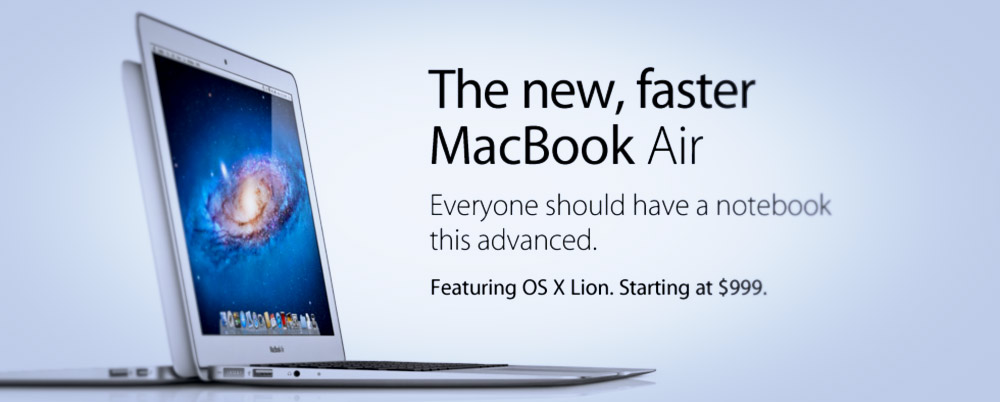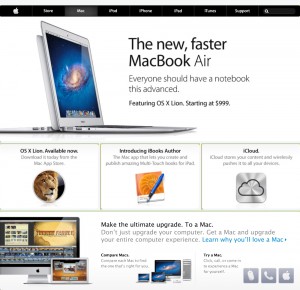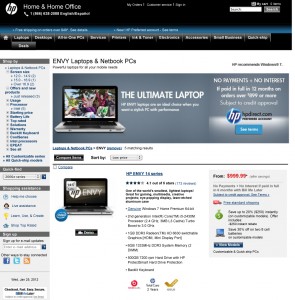
You can talk about what your product or service does.
Or you can talk about how the product/service makes the buyer feel.
Most companies talk objectively. “This is what we’re selling. It does X, Y and Z. It costs this much. It comes in these sizes/colors/whatever. How many do you want?”
Other companies, in contrast, talk about the feeling of owning said product or service – and they back it up in their communication. They’re as much – if not more – focused on the experience the customer may have after buying the product. They spend so much time and effort on customer experience because they know that’s how people buy.
The Difference Between Marketing & Selling
Take a look at the image below. It’s a screenshot from Apple’s website. It’s the way that Apple want you to see their MacBook Air laptop computer.

Now, take a look at the image below – again, you can click on it to enlarge it. As a comparison, this is a screenshot from HP’s website. It’s how you go about configuring and purchasing an HP laptop computer from their online store.

When looking at both images, don’t just compare the design of the respective pages. Consider the tone of the text.
Two totally different ways of selling a laptop computer. Is one way inherently ‘better’ than the other? Not at all.
Specs Don’t Tell The Whole Story
Sure, Apple just posted their biggest quarter ever (Apple sold more iPads alone than HP sold PCs). HP sells more PCs than Apple sells PCs, but Apple makes more profit on their products than HP does. Or indeed pretty much any other tech manufacturer.
Can you get a higher-specified PC for the cost of a Mac? While the so-called “Apple tax” has reduced in recent years, the answer is still a resounding ‘yes’.
But technical specifications like CPU clock speed, hard disk size, monitor resolution, or video RAM aren’t the primary reason that the ‘average’ computer buyer chooses what PC they should buy.
Today, pretty much any PC you buy is as fast and any other for the 95% of tasks most people use PCs. Email? Check. Organizing and editing photos? Check. Even basic video editing is now a given.
Some manufacturers, such as Apple, know that.
They know that, assuming a (technical) level playing field, they have to appeal to potential buyers in a different way if they’re to stand out in the minds of their customers.
Their answer is to focus on the customer experience. The way they talk to the customer before, during, and after the transaction. By investing more in industrial design than any competitor. By controlling the interaction with the language they use. By having a network of brick-and-mortar stores for customers to not only see the products, but having Apple staff use the same tone-of-voice and buying language. Finally, by offering a heightened level of after-sales service designed to get customers talking about their experience with their friends, family, and colleagues.
Doing all of the above is playing the long game. It’s also expensive. But all the evidence shows that, for Apple at least, marketing a product beats selling one hands-down.
Are You Marketing, or Just Selling?
How is your business promoting its value offering? Are you still talking about bits and bytes? About acronyms, minutiae and and techno-jargon that no-one but you and your staff care about?
Or are you selling the experience?
ABOUT THE AUTHOR

Gee Ranasinha is CEO and founder of KEXINO. He's been a marketer since the days of 56K modems and AOL CDs, and lectures on marketing and behavioral economics at two European business schools. An international speaker at various conferences and events, Gee was noted as one of the top 100 global business influencers by sage.com (those wonderful people who make financial software).
Originally from London, today Gee lives in a world of his own in Strasbourg, France, tolerated by his wife and teenage son.
Find out more about Gee at kexino.com/gee-ranasinha. Follow him on on LinkedIn at linkedin.com/in/ranasinha or Instagram at instagram.com/wearekexino.
Recent articles:
How Behavioral Science Thinking Improves Marketing Effectiveness

Dark Social: The Hidden Conversations Marketers Can’t See

Marketing In A Recession: How To Weather The Storm

How To Convince A Marketing Skeptic

Privacy Protection: Why Ad Tracking Must End

Marketing Isn’t About Being Brave: It’s About Being Effective

